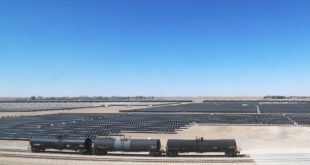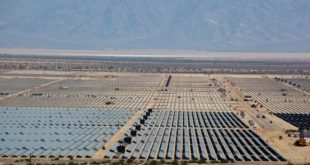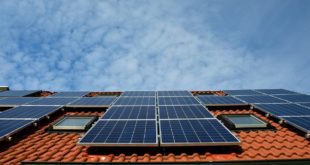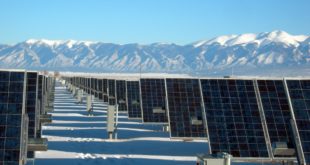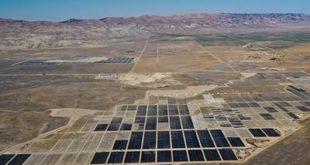By Michael Gorton, Chief Executive Officer and Chairman of Principal Solar
Despite the sluggish economy, the US solar industry has seen massive growth in the past two years, creating jobs across the country, driving innovation and attracting investors. In fact, solar installations reached 742MW in the second quarter, up 45 percent over the prior quarter, and a 116-percent increase over the period a year ago, according to GTM Research and the US-based Solar Energy Industries Association (SEIA).
Furthermore, utility-scale projects accounted for 447MW, with the full-year forecast for photovoltaic (PV) installations at 3.2GW, up 71 percent over record levels set in 2011. What’s more, solar is fast approaching grid parity, or the ability to compete on an even playing field with mainstream generation.
Currently, 46 percent of the nation’s electricity is generated from coal-fired plants, 23 percent from gas, 19 percent nuclear and 6.5 percent from hydro, according to the US Energy Information Administration. Even without government subsidies, solar utility scale projects are predicted to reach a price per KWh that will be at — or less than — traditional generation, possibly as soon as 2014, making solar the most promising and economical power partner on the horizon.
For many years, solar power was not a viable alternative source of energy, but the cost of PV declined exponentially year after year, just as electricity rose. Potentially, grid parity will occur when solar panels can be produced for under $0.70/watt. This number is based on the total cost of a system and the financing of a large-scale project using the same methods for financing a new combined cycle gas powered generating facility. Already, in 2012, PV modules are being sold under $0.90/watt and installed utility scale solar is approaching $2/watt.
The Case for Investing in Solar
PV solar is made from one of the Earth’s most abundant resources: silicon; it has no moving parts, and, as long as the sun continues to rise, the fuel is free. Of the 92 elements found on the periodic table, silicon (Si) is the Earth’s most prevalent semiconductor – and second most common element of any kind, after oxygen. Appearing in silicon oxides such as sand (silica), quartz, rock crystal, amethyst, agate, flint, jasper and opal, silicon makes up about a quarter, by weight, of the Earth’s crust, according to Solar World. It is clean, renewable and abundant.
As for cost, in response to growing demand for renewable energy sources, the manufacturing of solar cells and PV arrays has advanced considerably in recent years. With continued advances in technology and increases in manufacturing scale and sophistication, the cost of PV will continue to decline steadily resulting in competitive electricity in a growing number of regions. The annual exponential drops in the cost of solar will not only result in competitive electricity, but in cheaper electricity coupled with higher profit margins for the industry.
In looking at the spot market price for PV from 2009-2012, based on our research there is the same downward trend in cost for PV in Germany, China and Japan. Extrapolating two years ahead, solar PV may reach $0.70/kWh by 2013, and could be as low as $0.50/kWh by 2014. These numbers are supported by many of the largest solar cell and PV manufacturers. The projected 2014 price will make solar PV not only competitive with, but less expensive than nuclear, coal and natural gas.
When we combine a 2009 MIT study evaluating the resulting cost per kWh of new plants that would be constructed in 2009 with the cost per kWh of solar built in the same period, we see that the cost of building a nuclear power plant, coal and natural gas plant cost significantly lower electricity rates than solar PV. In 2014, however, solar and natural gas are level, and coal costs less, although a coal plant will probably cost more to build than it did in 2009. From these projections, 2014 is the year that solar may reach parity with nuclear, coal and natural gas. Leaping ahead to 2020, based on these projections solar will cost half against the Big Three.
Unused land throughout the desert southwest represents an abundant natural resource for solar energy. In fact, one county in West Texas sees enough sunshine to provide the entire needs of the US for the next 50 years. Still, it is not likely that solar will provide much more than 15 percent of the total grid power due, for the most part, to grid reliability. But no doubt many will compare the next few years to a gold rush, as billions of dollars are made from converting sunlight into electricity.
Solar has no fuel costs, low maintenance, and will provide carbon credits rather than carbon costs when compared to coal, nuclear and gas-fired power plants. As an addition to the nation’s power grid, it will ease congestion in energy-stressed grids and provide affordable power. Most importantly, it should produce electricity at a price that is equal to or lower than its competitors.
About the Author
Michael Gorton, Chief Executive Officer and Chairman of Principal Solar, is an entrepreneur, mentor and company builder, applying proven strategies in the fields of renewable energy, telecommunications, music and healthcare. Drawing on his extensive business expertise, scientific education and training, Michael serves as a strong voice and proponent of solar power. Over the past two years, Gorton has become a prolific author of technical papers and articles in solar and renewable energy. Gorton has earned degrees in engineering from Texas Tech, physics from the University of Texas and law from Texas Wesleyan University.
 Alternative Energy HQ solar power for homes, wind energy, and bio fuel issues
Alternative Energy HQ solar power for homes, wind energy, and bio fuel issues


